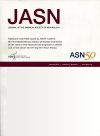Krüppel-Like Factor 6 Induces RNA Polymerase II Subunit RPB1 to Promote Kidney Injury
Single nuclear RNA sequencing after DNA damage–induced AKI identified an injured proximal tubule cluster with high Polr2a (RNA polymerase subunit B1), an RNA polymerase II subunit.POLR2A knockdown in injured cells decreased inflammatory and fibrotic gene expression, dedifferentiation, DNA damage, and cell cycle arrest.RNA polymerase subunit B1 was higher in mice overexpressing transcription factor Krüppel-like factor 6 and associated with worse injury after DNA damage.
Background
Initial proximal tubule cell injury and dedifferentiation contribute to AKI, and persistent dedifferentiation drives fibrosis and CKD. Proximal tubule–specific knockdown of zinc-finger transcription factor Krüppel-like factor 6 (Klf6) attenuates the AKI to CKD transition. Our aim was to study the early transcriptional mechanisms by which KLF6 induction exacerbates proximal tubular injury and eventual fibrosis.
Methods
Aristolochic acid I–treated wild-type and KLF6 overexpression mice underwent single nucleus (sn)RNA-seq and single nucleus assay for transposase-accessible chromatin sequencing (acute phase) and assessment of kidney function, injury, and fibrosis (remodeling phase). POLR2A was knocked down in human kidney cells and cell number, gene expression, differentiation, DNA damage, and cell cycle assessed. Kidney sections from fibrotic mouse models and human CKD secondary to aristolochic acid and diabetes were assessed for RNA polymerase subunit B1 (RPB1) expression.
Results
snRNA-seq identified an injured proximal tubule cluster with high expression of Klf6 and RNA polymerase II subunit a (Polr2a) encoding RPB1. After injury, RPB1-positive cells accumulated and were associated with dedifferentiated proximal tubules. POLR2A knockdown in injured cells increased cell death, but reduced inflammatory and fibrotic gene expression, dedifferentiation, DNA damage, and G2/M cell cycle arrest, with a transcriptional switch from long genes to short genes. Single nucleus assay for transposase-accessible chromatin sequencing demonstrated an open chromatin region in Polr2a intron 1 in injured proximal tubule cells, containing a KLF6-binding site. Knockdown of KLF6 reduced POLR2A induction, while proximal tubule–specific KLF6 further increased Polr2a levels after injury. Mice with tubule-specific KLF6 induction had more RPB1-positive proximal tubules and more injury post-AKI. Human kidney samples with DNA damage–induced CKD and diabetic kidney disease also had high POLR2A/RPB1 expression in dedifferentiated proximal tubule cells.
Conclusions
Prolonged high expression of RPB1 is associated with dedifferentiated proximal tubule cells. Mice overexpressing KLF6 had higher expression of RPB1 and worse kidney injury after DNA damage.




